Development Of A Next-Generation AAV Helper Plasmid With Improved AAV9 Productivity
By Lily Leveque-Eichhorn, Jinna Brim, Isha Ukani, Francis Grafton, Mohammad A. Mandegar, and Christopher A. Reid

Recombinant AAV (rAAV) vectors have demonstrated both safety and efficacy in delivering genetic material to patients. To date, their primary application has been in treating rare monogenic disorders. Expanding their use requires advancements in production methods to lower costs and enhance functional titers. Many current manufacturing platforms rely on transient transfection of a helper plasmid containing adenoviral genes E4, E2A, and VA-RNA to facilitate AAV replication.
Previous optimization efforts led to the development of a miniaturized AdV helper, now utilized in a split two-plasmid system supporting our customers. However, further optimization of viral element combinations is necessary to maximize AAV production.
In this study, we systematically deleted and rearranged components of an industry-standard Ad-helper construct to remove non-functional and deleterious regions. This engineered cassette achieved a >3-fold increase in AAV9 productivity and potency. Additionally, we employed the ATLAS (Arrayed Targeted Library for AAV Screening) platform for a high-throughput evaluation of viral elements, analyzing both individual and combinatorial effects on AAV9 production. Integrating top-performing targets from this screen into our minimal helper construct resulted in a >5-fold increase in AAV9 production compared to the industry standard vector.
This novel helper construct has been validated for improved potency and yield across multiple serotypes, including AAV2, AAV5, and AAV9. Ongoing experiments in an Ambr15 high-throughput model aim to assess potential quality impacts within our large-scale manufacturing platform.
Get unlimited access to:
Enter your credentials below to log in. Not yet a member of Outsourced Pharma? Subscribe today.
